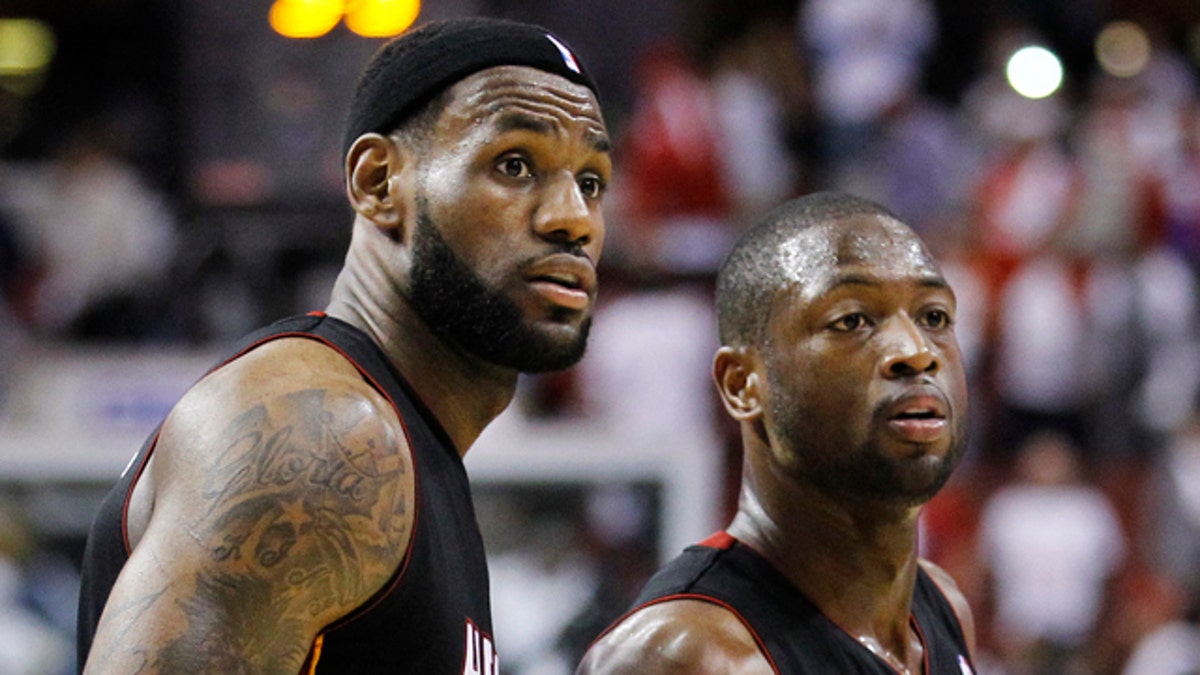
April 21: Miami Heat's LeBron James, left, and Dwyane Wade direct their attention toward the bench in the closing seconds of Game 3 of a first-round NBA playoff basketball series with the Philadelphia 76ers in Philadelphia. Miami won 100-94. (AP) (Tom Mihalek/All Rights Reserved 2010)
Yoga, Pilates, pedicures. They don't sound like the workout routine of a pro-basketball player. But Dwyane Wade, the superstar shooting guard with the Miami Heat, has embraced them.
During last year's lockout, players couldn't get access to NBA team facilities or trainers. "The lockout meant I was working out with a different trainer," said Wade, "and he introduced me to different types of workouts that I didn't even know my body needed, like yoga."
Wade, who turned 30 in January, could be considered old by NBA standards. He said a large part of his preseason training was focused on keeping his body healthy and injury-free through the season. Nevertheless, he has struggled with injuries, including a strained calf and sprained right ankle.
In addition to his time on the court and in the gym, Wade, who stands 6 feet 4 inches and weighs 220 pounds, puts in time on the massage table. "I'm huge on massage work," he said. "I've done more stretching this season than ever before. My therapist's hands get tired from working on me."
Since his size-15 feet take a lot of pounding, he also incorporates foot baths, ice baths and regular pedicures into his regimen. "You need to take care of your feet," said Wade. "My feet aren't going to look any prettier from a pedi, but they feel better from the massaging."
The workout
"I have tight hips and I felt I needed to loosen up and be more flexible as I got older," said Wade. He started taking private yoga lessons. "Just basic yoga—I wasn't ready for the hot stuff," he said. "Yoga is a totally different way of stretching and really challenging." Mr. Wade says he persuaded his teammate, LeBron James, to join him. "He's stiffer than me," he joked.
James, in turn, persuaded Wade to try machine-based Pilates, which lengthens muscles and strengthens the core muscles. "I really felt the Pilates loosen up my muscles," said Wade. The attention to stretching has paid off during the season. "I recall making a move, and the basketball ended up on my foot and I almost did a split on the ball. Normally, that's a groin pull, but I bounced back."
Wade also started running on the beach this summer. "Running on the sand strengthens your quads and calf muscles," he said. He adds that he used to avoid running because it gave him shin splints, but running barefoot in the sand has helped him avoid that. He does some runs for distance, others for speed. "I try to do a lot of quick sprints where I'm starting and stopping and training myself to push through fatigue," he said.
Wade has also worked on his fast-twitch muscles, which come into play for brief bursts of strength or speed. To do this, his trainer had him work out with elastic bands on his wrists and ankles. He throws a medicine ball, turns, and then catches the ball with his torso facing one way and his arms turning another. "In a game, you never know what is going to come at you. I have to be ready to react quickly."
The diet
Wade said he always avoided vegetables until he turned 30. "I hated all of them," he said. But "I knew it would help me in the long run both mentally and physically" to start eating them. His solution was to have his personal chef turn them into juice.
He now starts the day with a juice that might include celery, carrots and beets. His chef sticks to healthy, low-fat, high-protein meals that often include grilled chicken and rice. He doesn't splurge often, but when he does he has a burger, fries and a Coke. "That is heaven to me. I have a favorite burger spot in nearly every city. Sometimes I might even order two."
Pedicures: Putting your feet first
Wade has regular pedicures. But you won't find him at a salon getting his toenails painted. Cedric Bryant, the chief science officer for the American Council on Exercise, said Wade and many athletes get what's called a sports pedicure. "Your feet are vitally important, particularly in sports like basketball where you have a lot of impact stress from jumping and landing and a lot of torsional stress from the side-to-side movement that goes along with guarding players."
A sports pedicure, said Bryant, consists of soaking each foot in a warm Epsom-salt bath, applying foot cream, massaging the feet and lower legs, clipping the toenails and exfoliating dead skin from the soles of the feet.
"Regular sports pedicures reduce the development of blisters and calluses," said Bryant. "And the massaging can help with muscle soreness."
Bryant says wearing sports-specific socks will also help keep feet healthy. "Certain types of socks are designed to have a wicking effect to keep feet free of moisture and reduce the tendency toward developing blisters," he said.
